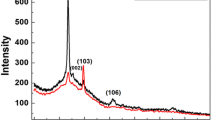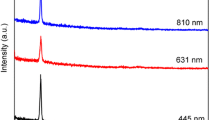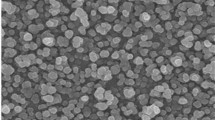Abstract
Cadmium selenide nanoparticle films were deposited on usual glass substrate by chemical bath deposition method. Temperature dependence of dc conductivity of the present samples was studied. In the nanocrystalline materials due to small size of grains and confined charge carriers, the electronic states near the Fermi level are localized. When states are localized, the conduction occurs by hopping of carriers between the occupied and unoccupied localized states. Variable range hopping was identified as a predominant conduction mechanism and occurs above room temperature. The density of localized states near the Fermi level was observed to increase with increase of average grain size in the film.
Similar content being viewed by others
Avoid common mistakes on your manuscript.
Background
In disordered materials, such as amorphous semiconductor or some thin films, low temperature transport occurs between localized electronic states near the Fermi level (EF). This transport depends on the density of states (DOS), location of Fermi level, and the temperature. Generally, at low temperatures (below about room temperature (RT)) and sometimes at temperatures above RT, the electrical conduction is interpreted by variable range hopping (VRH) mechanism [1–4]. High quality CdSe nanocrystals can be fabricated by several techniques such as electrodeposition, evaporation, and chemical bath deposition. In particular, chemical bath deposition (CBD) is one of the simplest and most economic techniques to grow stochiometrics CdSe thin films. A thin film formation takes place when ionic products exceed solubility. CBD method is presently attracting considerable attention as it does not require sophisticated instrumentation. It is relatively inexpensive, easy to handle, convenient for large area deposition, and capable of yielding good quality thin films. The characteristics of the chemically deposited CdSe thin films by CBD strongly depend on the growth condition; by changing the deposition key parameters, one can control thickness, size of the nanoparticles, and the energy band gap of the obtained thin films [5]. In this work, we investigate the temperature dependence of dc conductivity of CdSe semiconducting nanoparticle films.
Methods
The deposition solution was prepared by a process similar to that used by Mane and Lokhande [6]. A volume of 400 ml of 0.25 M cadmium acetate (to provide Cd2+ ions) was taken in a glass beaker of 1,000 ml capacity, under constant stirring, and then 25% ammonia was added to this solution slowly. At first, the solution become milky, and further addition of excess ammonia made the solution clear and transparent. Freshly prepared 0.25M Na2SeSo3 (400 ml) [5] was added slowly to the solution. The CdSe films were grown on ordinary glass slides. Before deposition, the substrates were washed in detergent, rinsed in acetone, ultrasonically cleaned, and finally rinsed again with a mixture of double distilled water and methanol.
The glass substrates were vertically immersed into the deposition solution, and the bath solution was covered. In order to control the rate of films growth, the bath temperature was kept constant at room temperature. In order to control the pH, ammonia is added to the solution, which contains Cd2+ ions. At the end of deposition process, all the deposited substrates were removed from the chemical bath at suitable intervals (4 to 24 h) and then washed with deionized water and methanol to remove the loosely adhered CdSe nanoparticles on the film. The coating of one side of each substrate was removed by cotton swab moistened with dilute HCl, and then the films were dried in the air and finally placed in the desiccators. The overall reaction is as follows [5]:
The films were structurally characterized by X-ray diffraction (XRD) using a Philip Analytical X-ray diffractometer in the 2θ geometry (Koninklijke Philips N.V., The Netherlands). The morphology of the films' surface was investigated by scanning electron microscopy. The dc electrical conductivity CdSe films was measured in a cryogenic Janis-CCS45 (Janis Research Company, LLC, Woburn, USA) system by a two-probe method in the temperature range of 300 to 450 K, using Keithley 610C (Keithley Instruments Inc., Cleveland, USA) and TTi-196Gp (Thurlby Thandar Instruments Ltd., Cambridgeshire, England) electrometers for current and voltage measurements. For this purpose, silver paint electrodes were painted on the samples in a coplanar configuration.
Results and discussion
Optical absorption
The absorption data were analyzed using the following well-known relation for near-edge optical absorption of semiconductors [5, 7],
where α is the absorption coefficient, (hυ) is the photon energy, A is a constant, Eg is the optical gap, and n is a constant equal to 1/2 for direct gap semiconductors and 2 for indirect gap semiconductors [5]. To estimate the optical band gap, the plot of (αhυ)2 versus (hυ) is shown in Figure 1. For as-deposited CdSe thin films, the best linear fit was obtained for n = 1/2 with various deposition times.
Brus considered a model for the energy band gap with particle size that yields the following expression for the band gap, ER, of the quantum dot,
where Eg is the bulk band gap, and R is the radius of the quantum dot. The third term arises due to the Coulomb attraction [8].
Dependence of the optical gap on the deposition time for the as-deposited thin films is shown in Figure 1. It is obvious that the optical gap decreases with increasing deposition time. This nanocrystalline films showed very strong confinement effects, as the reduction of grain size increases its energy band gap.
Microstructural and XRD studies
XRD patterns
The representative X-ray diffraction patterns for some of CBD-CdSe films are shown in Figure 2; the summary of the obtained results are presented in Table 1. As pH and deposition time are increased, the intensity and the line width of the XRD patterns (βhkl) get higher and smaller, respectively.
For the present samples, the X-ray patterns illustrate that the crystal structure of the CBD-CdSe is cubic [5]; for both as-deposited and samples with different pH values, no phase transition occurred.
Scanning electron microscopy
Representative micrographs are shown in Figure 3; Figure 3 shows the scanning electron microscopy pictures of the 6- (a) and 14-h (b) deposition times at pH = 11.6 with magnifications ×30,000. It can be observed that CdSe thin films cover the substrates. From the pictures, it is obviously seen that the film composed of small nanosized grains.
Electrical conductivity
In disordered materials such as amorphous semiconductor or some thin films, low temperature transport occurs between localized electronic states near the EF. This transport depends on the DOS, location of Fermi level and the temperature. Generally, at low temperatures (below about RT) and sometimes at temperatures above RT, the electrical conduction is interpreted by VRH [1, 2]; in this region, Mott's treatment of VRH leads to a temperature dependence for the electrical conduction of the form:
where To and σo are parameters related to the localization of wave functions γ, density of states at (or near) the Fermi level g(EF), optical phonon frequency νo, and the Boltzmann constant KB; To is given by:
Where Co is a constant, which has a value of approximately 16 (in the Mott's model [4], constant DOS) to about 310 (in the Godet's model [3], exponential behavior of DOS). Also, 1/γ is the decay length of the electronic wave function which typically ranges from 3 to 30 Å [1]. As mentioned before this, VRH behavior of conduction is observed in a number of thin film materials and not only at low temperatures and constant DOS, as was the original Mott's prediction, but also at high temperatures in nanocrystalline [1] and disordered materials [2, 4]. By considering the model proposed by Godet [3] for disordered materials and the similarity in conduction mechanism (VRH) of disordered and nanocrystalline semiconductors, we attempt to estimate the DOS of the CdSe nanoparticle films.
As discussed later, using Figures 4 and 5 and Equations 4 and 5, the DOS of CdSe are evaluated. The values of σo, To, DOS, and localization parameter (LP) g(EF) γ−3 obtained for CdSe nanoparticle films are summarized in Table 2 (values of Co = 16 and 310, and 1/γ = 10 Å have been used). It was observed that the DOS near the Fermi level increases with increase of grain size in films. It was observed that with increasing deposition time, activation energy is decreased, while the density of states is increased. We found that the density of states increased when annealing time is increased, while the activation energy decreased. These results show that the value of the density of states strongly depends on the annealing operation. We found that annealing times up to 6 h is very important; for the samples with lower annealing time variation of activation energy, density of states is less compared to the 6 h samples. Figure 4 shows the plot of lnσ versus 1/T for the present samples. All of these curves show a slope change in characteristic temperature (TR) of 330 to 340 K (TR has been obtained from the intersection of solid and dashed lines in each curve of Figure 4). As is clear in Figure 4, there are two regions with different slopes in each curve, one above TR and another below TR; the slope of lnσ − T−1 plot in the higher temperature region (called as Ea/KBT, where Ea is the activation energy) can be obtained. Figure 5 shows the plot of lnσ − T−1/4 in the lower temperature region (VRH region) of Figure 4. In the lower temperature range (region of lower slope, VRH region), the parameters To, σo, and DOS have been obtained from the slope of the plot of lnσ versus T−1/4 and its intercept at T−1/4 = 0 by employing the least squares method. The linear correlation factors were between 0.9987 and 0.9993. All of the obtained results are listed in Table 2. Recent works on the electrical properties of semiconductor nanocrystalline have paid considerable attention toward the electrical conduction mechanism. In the nanocrystalline materials, due to small size of grains and large grain boundaries, the electronic states near the Fermi level are localized. When the states are localized, the conduction occurs by hopping of carriers between the occupied and unoccupied localized states which depends on the density of state and the position of the Fermi level.
Temperature dependence of dc conductivity for CdSe nanoparticle films. pH = 11.6 for the best clarity; curves have been plotted separately. (a) pH = 11.6, deposition time = 6 h, non-annealed sample. (b) pH = 11.6, deposition time = 14 h, non-annealed sample. (c) pH = 11.6, deposition time = 14 h, non-annealed sample.
In summary, as illustrated in Tables 1 and 2, the density of localized states near the Fermi level have been deduced to increase with the increase of grain size in the CdSe nanoparticle films, which justifies Godet's model. The gradual decrease in the activation energy (existence of different slopes in the plots of conductivity) with temperature suggests that the conduction is due to the hopping of the carriers among the localized states. We suggest that the samples made by this method have a convenient characteristic for the investigation of nanosensing properties, because the density of state and electrical conduction change by external subject.
Conclusions
In this work, the effects of deposition time and annealing on the density of states of CdSe nanoparticle films, prepared by chemical bath deposition, were investigated. It was observed that in the higher pH, the grain size increased. In the nanocrystalline films, the charge carriers confined inside the nanoparticles, due to the reduction of grains size hence the electronic states close to the Fermi level, are localized. The gradual decrease in the activation energy with temperature suggests that the conduction is due to the hopping of the carriers among the localized states. The density of localized states near the Fermi level has been deduced to increase with increase of grain size in the CdSe nanoparticle films, in agreement with Godet's model. Our calculated localization parameters agreed with very small values of LP, where it corresponds to high temperature or low conduction. The localization parameters are due to confinement effect and confined charge carrier. For our system, modeling of ohmic conductivity for hopping within exponential distributions is useful in comparison with Mott's assumption of constant density of state near Fermi level. We suggest that the samples made by this method have a convenient characteristic for the investigation of nanosensing properties, because density of state and electrical conduction change by external subject.
References
Joshi RK, Sehgal H: Density of states near Fermi level in PbS nanoparticle films. Physica E. 2004, 23: 168.
Concari SB, Buitrago RH: Electronic transport mechanism in intrinsic and p-doped microcrystalline silicon thin films. J. Appl. Phys. 2003,9(4):2417.
Godet C: Variable range hopping revisited: the case of an exponential distribution of localized states. J. Non-Cryst. Solids 2002, 333: 299–302.
Mott NF, Davis EA: Electron Processes in Non-Crystalline Materials. Oxford: Clarendon; 1979.
Kale RB, Lokhande CD: Band gap shift, structural characterization and phase transformation of CdSe thin films from nanocrystalline cubic to nanorod hexagonal on air annealing. Semicond. Sci. Technol. 2005, 20: 1–9.
Mane RS, Lokhande CD: Chemical deposition method for metal chalcogenide thin films. Mater. Chem. Phys. 2000, 65: 1–31.
Tauc J, Menth A: States in the gap. J. Non-Cryst. Solids 1972, 569: 8–10.
Brus LE: Quantum crystallites and nonlinear optics. Appl. Phys. A 1991, 53: 465.
Author information
Authors and Affiliations
Corresponding author
Additional information
Competing interests
The authors declare that they have no competing interests.
Authors’ contributions
Both authors read and approved the final manuscript.
Authors’ original submitted files for images
Below are the links to the authors’ original submitted files for images.
Rights and permissions
Open Access This article is distributed under the terms of the Creative Commons Attribution 2.0 International License (https://creativecommons.org/licenses/by/2.0), which permits unrestricted use, distribution, and reproduction in any medium, provided the original work is properly cited.
About this article
Cite this article
Ghobadi, N., Moradian, R. Strong localization of the charge carriers in CdSe nanostructural films. Int Nano Lett 3, 47 (2013). https://doi.org/10.1186/2228-5326-3-47
Received:
Accepted:
Published:
DOI: https://doi.org/10.1186/2228-5326-3-47









